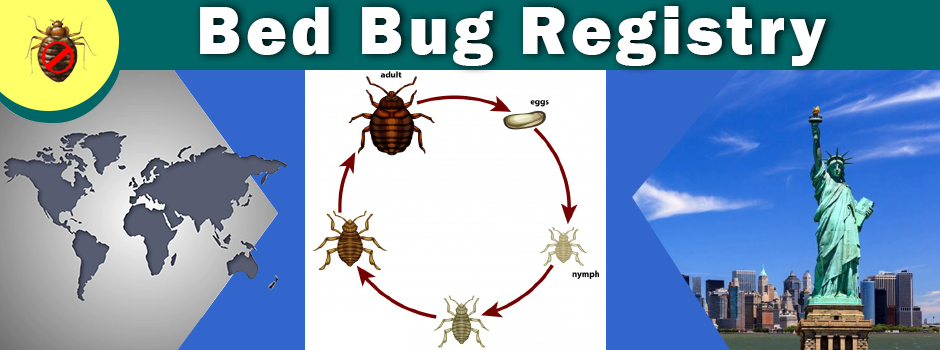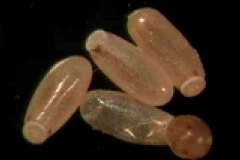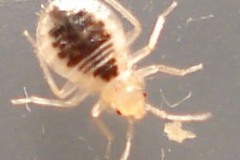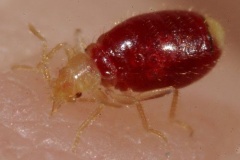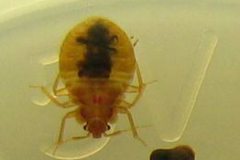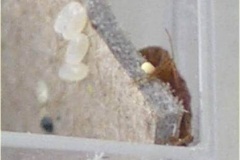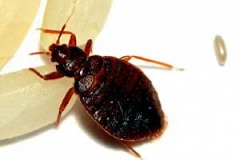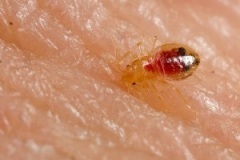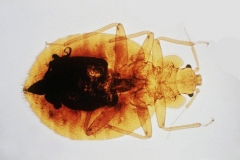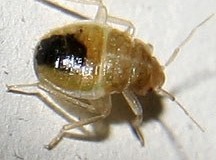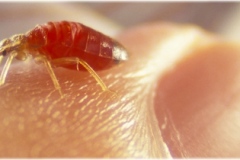Bed bugs are well known as annoying biting pests, and they are increasing in importance, including in hotels and other lodging establishments in the U.S. You are encouraged to learn more about the biology of bed bugs and their association with homes, apartments, hotels, and lodging establishments so that you can make more informed decisions about health risks, how to protect yourself when traveling, and whether bed bug control is warranted in a residence or lodging establishment.
Bed bugs require blood in order to reproduce and complete their life cycle. The effect of bed bug bites varies among people, but they eventually produce red welts that itch. The bites themselves are not painful and typically are not felt. However, frequent feeding can disrupt people's sleep and make them irritable, and seeing bites may cause emotional distress in some people. Heavy rates of feeding can result in significant blood loss and eventually lead to anemia, especially in malnourished children.
At least 27 agents of human disease have been found in bed bugs, including viruses, bacteria, protozoa, and parasitic worms. None of these agents reproduce or multiply within bed bugs, and very few survive for any length of time inside a bed bug. There is no evidence that bed bugs are involved in the transmission (via bite or infected feces) of any disease agent, including hepatitis B virus and HIV, the virus that causes AIDS.
Bed bugs belong to the family Cimicidae of the insect order Hemiptera, the group of insects known as "true bugs." In addition to the three species that are associated with humans, there are at least 88 species of Cimicidae in the world that live with and feed on bats or birds. Approximately 10-12 species of these bugs occur in the continental U.S., including four species in Indiana. Two species are known as "bat bugs," one is known as a "swallow bug," and one is known as a "purple martin bug." Bat bugs and swallow bugs typically feed on their bat or bird hosts, but will feed on humans if their normal sources of blood are not available. The effects of their bites are similar to those associated with the bites of bed bugs. There is no evidence that bat bugs and swallow bugs transmit disease agents to humans.
There are two additional groups of Hemiptera that bite humans, the so-called "kissing bugs" and "assassin bugs," both of which belong to the family Reduviidae. Kissing bugs feed on the blood of mammals and birds, and transmit a protozoan parasite that causes a disease of humans known as "Chagas Disease." Chagas Disease is widespread in Central and South America, and an occasional case occurs in Texas. Assassin bugs, instead of being blood feeders, are predators on other insects, including crop pests. They are beneficial insects, but they will bite humans if mishandled, and the bites are very painful.
There is only one species of bed bug in Indiana, Cimex lectularius. This species is a pest of humans worldwide, including the entire U.S., and has over 50 common names, among them "mahogany flat," "redcoat," "wall louse," and "bed louse." A second species of bed bug, Cimex hemipterus, is limited to tropical regions of the world. A third species of bed bug, Leptocimex boueti, lives with and feeds on both humans and bats in West Africa.
Adult bed bugs are about inch long, oval, reddish-brown, and wingless. Their body is very flat, and they possess long, slender legs and antennae. They have a long, segmented proboscis (beak) that extends forward when the bug takes a blood meal. At rest, the proboscis lies beneath the body and projects backwards between the legs. Immature bed bugs are known either as "larvae" or "nymphs." They closely resemble adults, but are smaller and less deeply pigmented.
Bed bugs develop from egg to adult via a process called "gradual metamorphosis." This means the last larval stage develops directly into an adult without passing through a non-feeding pupal stage. There are five larval stages, and each one requires a blood meal before molting into the next life cycle stage. Both adult male and female bed bugs feed on blood and take repeated blood meals during their lives. Females require blood for the development of eggs.
The five larval stages are completed in about a month under suitable conditions of temperature, humidity, and availability of hosts for blood meals. Larvae can survive inside dwellings for several months without a blood meal, but they do not molt into the next life cycle stage until they engorge on blood. Adults can survive even longer under the same conditions, but, again, do not develop eggs unless they feed on blood.
back to top
Visit link:
Bed Bugs | Public Health and Medical Entomology | Purdue ...

 Residence
Residence  Location
Location 
